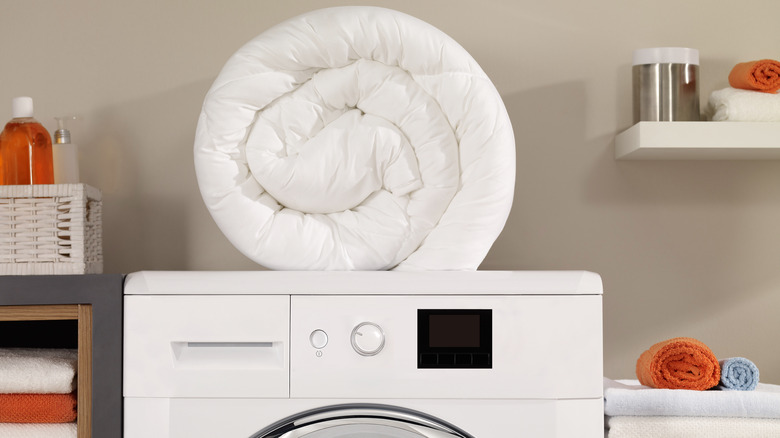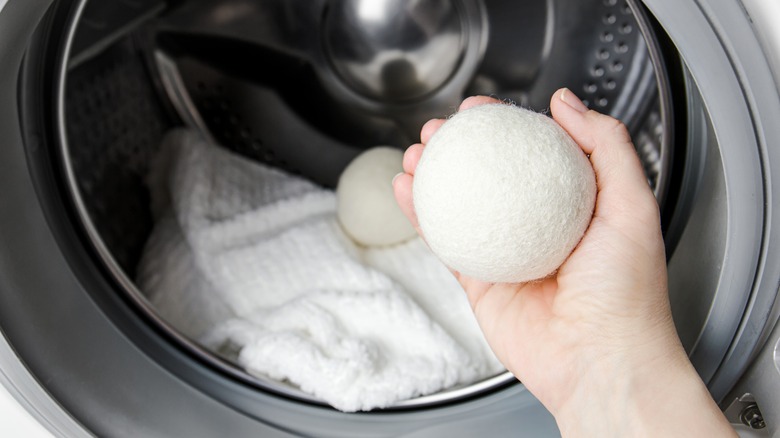Important Things To Know When Drying Your Down Comforter To Not Ruin It
Few things feel as luxurious as a fluffy, cloud-like down comforter. But maintaining your down comforter can be a stressful task, especially when it comes to laundry day. Will throwing it in the dryer make it lose its lofty, airy qualities? Should you leave it to hang outside, even though it can take hours, if not days, to dry and risk developing mold? The good news is that you might be overthinking it — it doesn't have to be that complicated. Thankfully, you can in fact safely dry it in a dryer after washing your down comforter. It even has the benefit of not requiring sunny warm weather like line drying, and actually helps to fluff up the down. But to do so without damaging the down stuffing, there are a few things you need to implement that probably differ from your usual laundry routine.
To start, you'll need a large-capacity dryer in order to dry your down comforter successfully. That's because smaller tumblers don't offer enough space for the down to expand and regain its fluffiness, which results in compacted, clumpy down. If you don't have a large-capacity dryer, you may be best off taking your comforter to a laundromat that has bigger machines. This can be a bit inconvenient and adds a small cost, but it will help to ensure your comforter stays lovely for longer. Beyond a large tumbler, there are some other small routines you can implement to make this process even easier and more efficient.
Dryers can't do it all
While you are able to use a dryer after laundering your down comforter, it's not as simple as just turning the machine on and walking away. To help prevent the down from settling into clumps, we recommend adding wool dryer balls or even just regular tennis balls into the tumbler. These help to break up clumps as the comforter rolls around in the tumbler, and can even help to prevent it from tangling, which can lead to spotty drying patterns.
Wool dryer balls are great because they are designed specifically for this task and have added benefits, like reducing static and softening fabric. Tennis balls do a good job at manually breaking up clumps, but don't have the extra perks and can sound quite noisy knocking around in the dryer. In addition to dryer balls, you should periodically remove the comforter from the dryer during its cycle and shake it out. That way you can spot if some sections are still wet and reintroduce air into the down.
Be sure to pay attention to the dryer settings themselves as well. It's tempting to just put it on its highest temperature setting when you're laundering such a heavy item, but this can damage the down. Instead, use a low-heat, tumble-dry setting. While these cycles take longer, they ensure more even drying and won't damage or compact the down.
Be patient when drying down comforters
When the dryer timer goes off, don't lob the duvet cover on and call it a day. You need to check that the comforter and down are fully dry (not just to the touch), because putting an even slightly wet comforter on the bed can cause mold and mildew. Dense comforters can make it a bit tricky to determine if it's completely dry, but one way to tell for sure is with a smell check. Wet down has a distinct smell, so if you can detect no odor and don't feel any wet spots, the comforter is sufficiently dried.
Before putting a duvet cover back on the comforter, be sure to give it one final shake-out. Lying it across the bed so it's flat is a good way to do this so the maximum surface area possible can have air reintroduced, and no sections will be left untouched. These small changes can help prolong the heavenly fluffiness of your comforter. One note is that you should always check out the manufacturer's label on your comforter before using these tips and tricks. Our advice is general, and your comforter may have care instructions specific to the materials it contains — for instance, if the down is a mix of artificial and natural feathers.


